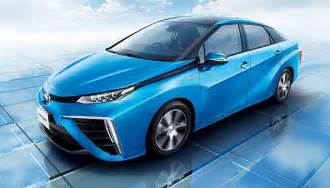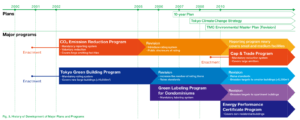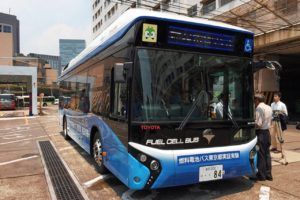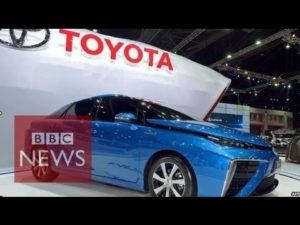Tokyo’s surprise for the 2020 Olympics – Hydrogen, the energy for next generation

Tokyo is warming up for the 2020 Olympics. It will be the second time for the capital city of Japan to host the event. During the Olympics in 1964, Tokyo surprised the world by introducing the fastest, safest, and most reliable bullet train, the “Shinkansen”. What can we expect from Tokyo in the next Olympics?
Climate change effects to Tokyo
Historical data of the Japan Meteorological Agency (JMA) shows that annual average air temperatures in Japan rose by a rate 50% higher than the global mean temperature rise over the last century. Experts view that Japan’s temperatures are likely to increase by 2°C to 3°C during this century, others view that it could even rise by 4.8°C by 2100. In certain parts of Japan, the availability of seasonal vegetables and certain fish has changed or delayed in some areas. The phenomenon articulates the limits of some plants and animals against climate change and make us fear the potential impact to Japanese culture and industries. For instance, one of the major impact will be on the rice harvest, which will suffer a decrease of up to 40 percent in central and southern Japan. As of today, 60 percent of the nation’s food is imported and a further rise of it’s proportion could impact the food and agriculture industry of the country. (For comparison, the United Kingdom imports about 25 percent of its food, and the United States exports more food than it imports) [1].
Tokyo action plans towards 2020
To resolve the situation, Tokyo Metropolitan Government (TMG) has rolled out the climate change strategy that involves all sectors in the city (see Table A). The main drivers of the strategy are Commercial & Industrial sector, Residential sector, and Transportation sector. In 2010, the world’s first urban cap-and-trade program was introduced by the Industry and Commercial sector. A series of Green Building programs which requires a thorough environmental qualification for new buildings were implemented by the Residential sector [2].
Table A History of Development of Major Plans and Programs [3]
Hydrogen development in action
For the transportation sector, TMG has set up a ¥40 billion ($330 million) fund to promote the use of hydrogen energy and build up Japan’s ecological technologies ahead of the 2020 Olympic Games. The fund covers the cost of building hydrogen stations, promoting fuel cell vehicles, and providing fuel cells for business and industrial use. Experts view hydrogen as a prime energy source because it does not emit carbon dioxide when burned and emits only water as a byproduct. It also contributes to a new source for energy security after the Fukushima nuclear disaster, because hydrogen can be sourced from all over the world. TMG views this project not only for the Olympics, but also to promote renewable energy to create a sustainable society for the future of Japan.
Since 2013, there have been 105 hydrogen station built nationwide (compared to less than 40 public hydrogen stations in US), over 3,000 gas fuel vehicles, and 2 gas fuel public buses started operation last September.
Going forward, TMG targets 150 hydrogen stations, 6,000 gas fuel vehicles, and 100 gas fuel public buses by 2020 and 250 station and 100,000 gas fuel vehicles by 2025 [4].
Recommendations
- There are high expectations for hydrogen, but there are also many hurdles to overcome, including how to lower the cost of using it. For now, TMG offers subsidies on purchases of fuel-cell cars. For example, the Mirai, Toyota’s car is going for around 4.2 million yen, or $35,000, after incentives from Tokyo and the central government that slash the price by more than a third. There needs to be constant challenges to lower the price to an affordable level [4].
- Compared with regular gas stations, hydrogen stations require higher capital investments. To absorb the intensive capital, more fuel-cell cars are expected on the road. However, the cars will be limited by the number of and accessibility to hydrogen station. The external environment is more or less of a headwind. Because of the Fukushima nuclear accident, many power companies are strapped for cash. Furthermore, manufacturers see little attraction in hydrogen when coal and natural gas prices are low. Both government and private sector needs to align their plans to create a new society [5].
- What cannot be left out is the education towards the society. Public awareness is still relatively low about the advantages and safety guidelines of the energy. The fuel cell car’s benefits of long distance (over 300 miles when fully charged), short idle time for battery charge (less than 15 seconds), and zero emission of CO2 should be a great merit to the consumers. A misconception of “danger” against Hydrogen shall be removed by proper advertisement and education as well.
Thoughts for the future
To make hydrogen energy something anyone can use, the whole society must get on board. How can Tokyo Metropolitan Government , Japanese government, and the private sector further spread the vision to it’s people and the world ?
Word count: 770
Citation
[2] http://www.kankyo.metro.tokyo.jp/basic/gaiyou.pdf
[3]http://www.kankyo.metro.tokyo.jp/en/climate/On%20the%20path%20to%20a%20low%20carbon%20city_A3.pdf






Very interesting that Tokyo as a municipality has chosen to invest in the hydrogen route. That said, I must be skeptical about its sustained success. Hydrogen vehicles and infrastructure depend on scale to succeed (as you pointed out), however, most of the green vehicle market appears to be shifting towards battery propulsion. Tesla is the well known pedestrian vehicle example, but commercial bus supplier Proterra has also seen great success.
Perhaps Japan can create enough domestic scale for a viable hydrogen vehicle ecosystem, but it is hard to imagine that the costs would be lower than an international effort pushing towards battery electric vehicles.
I love Hydrogen car idea! I believe this will be a great move in car industry. My concern is, as Japan is a country with relatively small size, the impact of changing the fuel within the country is quite limited on the global warming issue. So it is important to implement this not only within the country, but more importantly, bringing this positive impact to the world. I think of two approaches: 1) Japanese car brands are big players in the world. So the car companies, such as Toronto, can play an important role by exporting hydrogen cars to other countries. 2) Japan is influential country in the world as it has developed economy and advanced technology. So Japanese government can also play an active role in promoting the idea in global conferences.
My another challenge is about the infrastructure for hydrogen car. It is known that one of the biggest challenge for electronic car is the lack of the infrastructure, namely, the electric car charging station. Many years passed since the launch of electric cars, but still the charging stations are not build in enough scale. How long will it take to have enough hydrogen stations?
But I still favor hydrogen cars over battery electric cars (to the comment of Minecraft), because the way to produce electricity varies. Not all electricity is clean energy as some of them are produced by burning coal. While hydrogen is the energy that exists in the air.
Nice write up! While I completely agree that the cost of hydrogen is currently prohibitive for it to sustainably fuel a majority of cars in Japan, I think there’s potentially substantial benefit to take a loss to ensure these cars are up and running during the Olympic Games, when Tokyo has the attention of the world. This could do a significant amount to, like the Shinkansen back in the 1960s, impress the world and again highlight Japan as a forward-thinking automative power, and potentially: 1) attract additional outside investment to iterate on the current version and lower costs, and 2) encourage other countries to invest in hydrogen, thereby expanding the impact that Japan can have outside its (as Mengwen noted) relatively small walls.
Nice article! I love the idea of Tokyo getting behind hydrogen as an alternative energy source. I also had no idea that Japan introduced the Shinkansen during the 1964 Olympics.
In addition to the measures already in place and that you have suggested to promote hydrogen as an energy source and to reduce CO2 emissions, I think Tokyo may be able to learn from a strategy implemented in London. Since 2003 Transport for London (government body responsible for transportation in Greater London) has implemented a congestion charge – a fee charged on most motor vehicles driving within the Congestion Charging Zone in central London, from which electric (and some hybrid) cars are exempt [1]. it is effectively a road tax, which aims to:
(1) reduce road traffic
(2) reduce pollution
(3) raise funds for the City of London’s transport system.
By following London’s example and implementing such a scheme, perhaps TMG will be able to disincentivise Tokyo’s people from driving traditional cars, and in so doing slowly start to change their mindset to move towards renewable energy sources such as hydrogen. In addition, the tax revenues generated can be used to fund further development of hydrogen stations (which as you highlight, require high capital investment), or can be used by the government to fund educational initiatives to change public perception.
[1] https://tfl.gov.uk/modes/driving/congestion-charge
Great read! Having written a thesis on how the Chinese central government could reduce air pollution in China from power generation, this topic is deeply important to me. I think hydrogen cars is an exciting innovation, but the question to me is how the Japanese government (and the world) might prioritize investment in scaling this technology relative to other means of reducing greenhouse gas emissions. Because of the large costs involved, the Japanese government might identify and focus on the biggest drivers of emissions, which appears to be industries (e.g., factories, double the emissions of the transport sector) [1]. Thus, it might focus on reducing emissions in other sectors in the short term. A cost/benefit analysis might also indicate that Japan is uniquely suited to take other innovations to scale, and could wait for others to develop the hydrogen car technology first. In conclusion, the government should invest in areas to get the biggest bang for its buck to reduce emissions, which may or may not be the hydrogen car in the short term.
[1] https://www.iges.or.jp/files/research/alliges/pdf/20160128/6_GIO_eng.pdf
Very nice article. It was really interesting to learn how Japan is gearing themselves up for 2020 Olympics and becoming resilient to climate change, both short term as well as long term.
Honda and Toyota’s involvement in this initiative [1] is definitely the first step in gathering support from private sector as well as their employees.
One of my concerns about doing this, however, is the lack of international research that could accelerate this transition, especially with big alternate fuel car proponents like Elon Musk rejecting the idea [2]. Do you think there is a possible way in which it will be possible to get more consensus internationally as well as locally?
[1] Harding R., 2017, “Japan is betting future cars will use hydrogen fuel cells”, Financial Times.
[2] Watanabe C., 2017, “Japan Is at Odds With Elon Musk Over Hydrogen Fuel Cells”, Bloomberg.